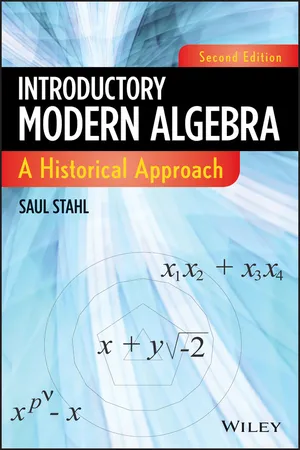
- English
- ePUB (mobile friendly)
- Available on iOS & Android
About this book
"Stahl offers the solvability of equations from the historical point of view...one of the best books available to support a one-semester introduction to abstract algebra."
—CHOICE
Introductory Modern Algebra: A Historical Approach, Second Edition presents the evolution of algebra and provides readers with the opportunity to view modern algebra as a consistent movement from concrete problems to abstract principles. With a few pertinent excerpts from the writings of some of the greatest mathematicians, the Second Edition uniquely facilitates the understanding of pivotal algebraic ideas.
The author provides a clear, precise, and accessible introduction to modern algebra and also helps to develop a more immediate and well-grounded understanding of how equations lead to permutation groups and what those groups can inform us about such diverse items as multivariate functions and the 15-puzzle. Featuring new sections on topics such as group homomorphisms, the RSA algorithm, complex conjugation, the factorization of real polynomials, and the fundamental theorem of algebra, the Second Edition also includes:
- An in-depth explanation of the principles and practices of modern algebra in terms of the historical development from the Renaissance solution of the cubic equation to Dedekind's ideals
- Historical discussions integrated with the development of modern and abstract algebra in addition to many new explicit statements of theorems, definitions, and terminology
- A new appendix on logic and proofs, sets, functions, and equivalence relations
- Over 1,000 new examples and multi-level exercises at the end of each section and chapter as well as updated chapter summaries
Introductory Modern Algebra: A Historical Approach, Second Edition is an excellent textbook for upper-undergraduate courses in modern and abstract algebra.
Frequently asked questions
- Essential is ideal for learners and professionals who enjoy exploring a wide range of subjects. Access the Essential Library with 800,000+ trusted titles and best-sellers across business, personal growth, and the humanities. Includes unlimited reading time and Standard Read Aloud voice.
- Complete: Perfect for advanced learners and researchers needing full, unrestricted access. Unlock 1.4M+ books across hundreds of subjects, including academic and specialized titles. The Complete Plan also includes advanced features like Premium Read Aloud and Research Assistant.
Please note we cannot support devices running on iOS 13 and Android 7 or earlier. Learn more about using the app.
Information
Chapter 1
THE EARLY HISTORY
1.1 The Breakthrough









Table of contents
- Cover
- Half Title page
- Title page
- Copyright page
- Preface
- Chapter 1: The Early History
- Chapter 2: Complex Numbers
- Chapter 3: Solutions of Equations
- Chapter 4: Modular Arithmetic
- Chapter 5: The Binomial Theorem and Modular Powers
- Chapter 6: Polynomials Over A Field
- Chapter 7: Galois Fields
- Chapter 8: Permutations
- Chapter 9: Groups
- Chapter 10: Quotient Groups and Their Uses
- Chapter 11: Topics in Elementary Group Theory
- Chapter 12: Number Theory
- Chapter 13: The Arithmetic of Ideals
- Chapter 14: Abstract Rings
- A. Excerpts from Al-Khwarizmi’s Solution of the Quadratic Equation1
- B. Excerpts from Cardano’s Ars Magna1
- C. Excerpts from Abel’s A Demonstration of the Impossibility of the Algebraic Resolution of General Equations Whose Degree Exceeds Four1
- D. Excerpts from Galois’s On the Theory of Numbers1
- E. Excerpts from Cayley’s The Theory of Groups1
- F. Mathematical Induction
- G. Logic, Predicates, Sets, and Functions
- Biographies
- Bibliography
- Solutions to Selected Exercises
- Index
- Notation